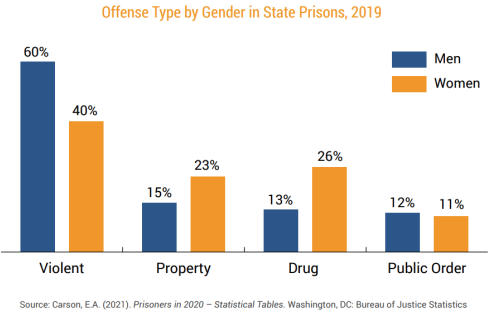Female criminal behavior has been commonly perceived as a less serious problem than male criminal behavior. This is largely due to crime itself being characterized as a “masculine behavior,” making it more likely to be acted out by a male. Historically, women have been more likely to commit minor offenses while men a more likely to commit serious or violent offenses. Although women remain a relatively small number of the United States inmate population, they have become the fastest growing population in our jails and prisons. Since 1990 the number of female defendants convicted of felonies in State courts has grown at more than two times the rate of increase in male defendants. While men still commit more felonies and violent crimes than women, women’s rates are rising faster than men’s. The number of incarcerated women was nearly five times higher in 2020 than in 1980.311
There is a sex gap in types of crimes committed. The percentage of women in prison for drug and property crimes is considerably higher than for men in prison. However, it is important to mention that these figures demonstrate incarceration rates for offenses rather than arrest rates for the same offenses. For all persons arrested for property crime in 2019, 62.3 were men.312 So while more men committed (or were arrested for) property offenses more often than women, the percentage of women incaracerated for this offense outweighs the percentage of men incarcerated for the offense.

Figure \(10.4.1\): Graph of Offense Type by Gender in State Prisons, 2019313
Women primarily commit petty property crimes, such as shoplifting, fraudulent checks, and
welfare fraud. The sex gap in these types of offenses are often explained through the increasing
feminization of poverty. The femininization of poverty refers to the sex gap in living standards
due to the gender gap in poverty.314 Women and children are disproportionately represented
within the lower socioeconomic status community in comparison to men.315 It's interesting to
point out here that women’s crime trends tend to follow the traditional feminine roles in
society as shoppers, consumers, and health care providers within the family. So, what does this
mean? Are women just naturally more prone to steal? Do their biological make-up,
evolutionary process, and hormone levels preprogram them for theft? No. Remember from
previous chapters:
- Femininity, like masculinity, is socially constructed and not simply ‘natural.’
- Femininity is a product of socialization, not estrogen.
- Femininity, like masculinity, is a series of learned behaviors.
- There are systemic factors contributing to the sex gap in larceny offenses, such as the feminization of poverty, wage gap, gender imbalance in parental duties affecting schooling and jobs, etc.
Women are consistently less likely commit violent offenses. In 2019, about 17% people arrests for a violent offense was a woman. In addition, women accounted for 12% of arrests in murder in anon-negligent manslaughter, 3.4% in arrests for rape, 16% in arrests for robbery, 23.5% for arrests in aggravated assault, 21% in arrests for violent arson, and 29% in arrests for "other assaults".316 Here we can see the disproportionate amount of men committing violent crimes in each of the typologies. So, what does this mean? Are men just naturally more violent? Do their biological make-up, evolutionary process, and hormone levels preprogram them for violence? No. Remember from previous chapters:
- Masculinity, like femininity, is socially constructed and not simply ‘natural.’
- Masculinity is a product of socialization, not testosterone.
- Masculinity, like femininity, is a series of learned behaviors.
- There are systemic factors contributing to the sex gap in violent offenses such as Western masculine ideals requiring boys and men to confront violence and be skilled in the use of violence in those confrontations.
- Most boys and men who are not accomplished fighters are often viewed as being more vulnerable by those who are.
- Masculinity is a performance. One aspect of the performance of masculinity is being tough and/or violent (or at least willing to be).317
More than half of female violent offenders were white, and just over a third were black. About 1 in 10 were described as belonging to another race (Asian, Pacific Islander, Native Hawaiian, American Indian, Aleut, or Eskimo). Black and white offenders accounted for nearly equal proportions of women committing robbery and aggravated assault; however, simple assault offenders were more likely to be white.
311 Bureau of Justice Statistics. (2021). Prisoners Series (1980-2020). Washington, DC.
312 FBI: UCR. 2019 Crime in the United States. https://ucr.fbi.gov/crime-in-the-u.s...rsons-arrested
313 Graph by E. Ann Carson, BJS, is in the public domain
314 Schaffner Goldberg, G. (2009). 'Feminization of Poverty in The United States: Any Surprises?', Poor Women in Rich Countries: The Feminization of Poverty Over the Life Course (New York; online edn, Oxford Academic).
315 Christensen, M., et. al. (2019). "Feminization of Poverty: Causes and Implications", Gender Equality, Encyclopedia of the UN Sustainable Development Goals, Cham: Springer International Publishing, pp. 1–10.
316 FBI: UCR. (2019). Table 42: Arrests by Sex, 2019. https://ucr.fbi.gov/crime-in-the-u.s...e-in-the-u.s.- 2019/topic-pages/tables/table-42
317 Earp, J., Katz, J., Young, J. T., Jhally, S., Rabinovitz, D., & Media Education Foundation. (2013). Tough guise 2: Violence, manhood & American culture.



